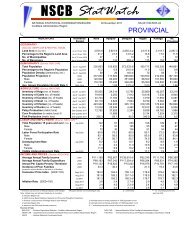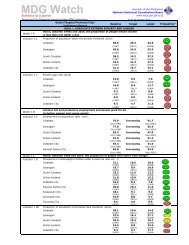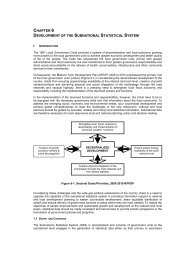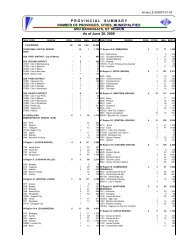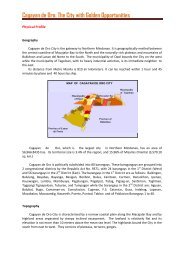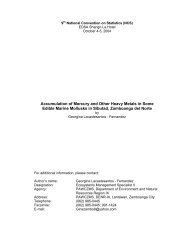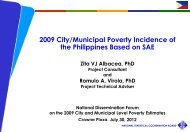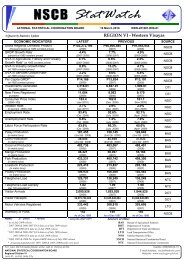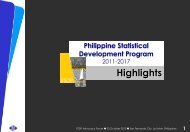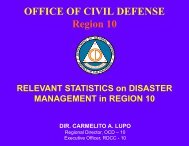Academic Programs in Statistics in the Philippines - NSCB
Academic Programs in Statistics in the Philippines - NSCB
Academic Programs in Statistics in the Philippines - NSCB
Create successful ePaper yourself
Turn your PDF publications into a flip-book with our unique Google optimized e-Paper software.
<strong>Academic</strong> <strong>Programs</strong> <strong>in</strong> <strong>Statistics</strong> <strong>in</strong> <strong>the</strong> Philipp<strong>in</strong>esbyLisa Grace S. Bersales 1ABSTRACTThe first academic program offered <strong>in</strong> <strong>the</strong> Philipp<strong>in</strong>es was <strong>the</strong> Master of Arts <strong>in</strong><strong>Statistics</strong> program of <strong>the</strong> Statistical Center, now <strong>the</strong> School of <strong>Statistics</strong>, of <strong>the</strong> Universityof <strong>the</strong> Philipp<strong>in</strong>es. This was <strong>in</strong>stituted <strong>in</strong> 1954. At present, many schools nationwide offerundergraduate and graduate programs <strong>in</strong> statistics. Thus, after 50 years, <strong>Statistics</strong> <strong>in</strong> <strong>the</strong>Philipp<strong>in</strong>es has found recognition as a discipl<strong>in</strong>e <strong>in</strong> itself. <strong>Academic</strong> <strong>in</strong>stitutions produce<strong>the</strong> statistical manpower for government, bus<strong>in</strong>ess and <strong>in</strong>dustry, and <strong>the</strong> academe.Fur<strong>the</strong>rmore, <strong>the</strong>y contribute research and tra<strong>in</strong><strong>in</strong>g services <strong>in</strong> <strong>the</strong> country.A survey of academic <strong>in</strong>stitutions that offer <strong>Statistics</strong> and AppliedMa<strong>the</strong>matics/<strong>Statistics</strong> programs show encourag<strong>in</strong>g statistics. However, <strong>the</strong>re is still aneed to attract more students, produce more graduates, enhance <strong>the</strong> academicprograms, and provide more facilities. The paper shall present <strong>the</strong>se statistics and giverecommendations on how to enhance <strong>the</strong>ir academic programs, attract more studentswith potential, and produce more graduates.I. The Birth of <strong>Statistics</strong> Education <strong>in</strong> <strong>the</strong> Philiip<strong>in</strong>esThe seed of higher level of education <strong>in</strong> <strong>Statistics</strong> <strong>in</strong> <strong>the</strong> Philipp<strong>in</strong>es wasplanted <strong>in</strong> 1952 when <strong>the</strong> first board of directors of <strong>the</strong> Philipp<strong>in</strong>e StatisticalAssociation discussed <strong>the</strong> possibility of establish<strong>in</strong>g an <strong>in</strong>ternational statisticalcenter <strong>in</strong> Manila under <strong>the</strong> dual sponsorship of <strong>the</strong> Philipp<strong>in</strong>e government and <strong>the</strong>United Nations (Lorenzo, 1953). This recommendation was a result of <strong>the</strong>irobservation that staff do<strong>in</strong>g statistical work <strong>the</strong>n did not have formal tra<strong>in</strong><strong>in</strong>g <strong>in</strong>statistics. At that time, college education offered only three units of elementarystatistics and <strong>the</strong>re were no undergraduate and graduate programs <strong>in</strong> statistics <strong>in</strong><strong>the</strong> Philipp<strong>in</strong>es.In 1953, <strong>the</strong> Statistical Center was established under a bilateral agreementbetween <strong>the</strong> Phlipp<strong>in</strong>e government and <strong>the</strong> United Nations. Its first academicprogram, Master of Arts <strong>in</strong> <strong>Statistics</strong>, was <strong>in</strong>stituted <strong>in</strong> 1954. It was formally turnedover to <strong>the</strong> University of <strong>the</strong> Philipp<strong>in</strong>es <strong>in</strong> 1963 and , <strong>in</strong> 1998, it was renamed <strong>the</strong>School of <strong>Statistics</strong> of <strong>the</strong> University of <strong>the</strong> Philipp<strong>in</strong>es <strong>in</strong> Diliman.II.Current <strong>Academic</strong> <strong>Programs</strong> <strong>in</strong> <strong>Statistics</strong>A study commissioned by <strong>the</strong> Technical Panel on Science andMa<strong>the</strong>matics of <strong>the</strong> Commission on Higher Education (CHED) listed eleven (11)schools offer<strong>in</strong>g academic programs <strong>in</strong> <strong>Statistics</strong> as of 1999 ( Bonzo andPatungan, 2000). At present, eighteen (18) schools offer such programs. Thefollow<strong>in</strong>g table, Table 1, lists <strong>the</strong>m and <strong>the</strong> programs <strong>the</strong>y offer: It should be notedthat <strong>the</strong> list does not <strong>in</strong>clude schools that may have programs <strong>in</strong> appliedma<strong>the</strong>matics which <strong>in</strong>clude statistics as a specialization but do not have formalstatistics programs.1 The author is a Professor of <strong>Statistics</strong> and Dean of <strong>the</strong> School of <strong>Statistics</strong> of <strong>the</strong> University of <strong>the</strong>Philipp<strong>in</strong>es <strong>in</strong> Diliman



